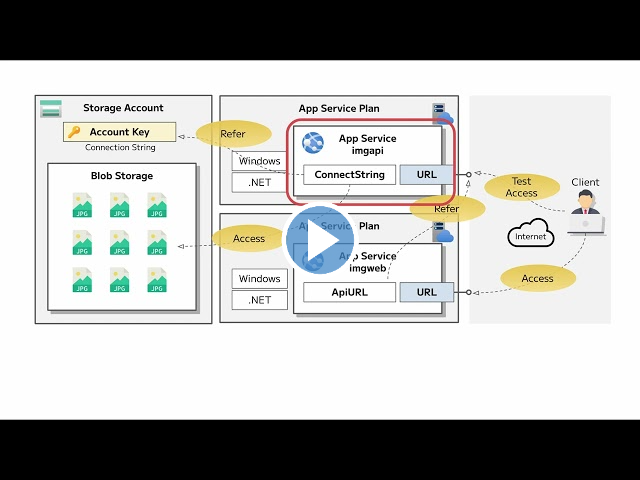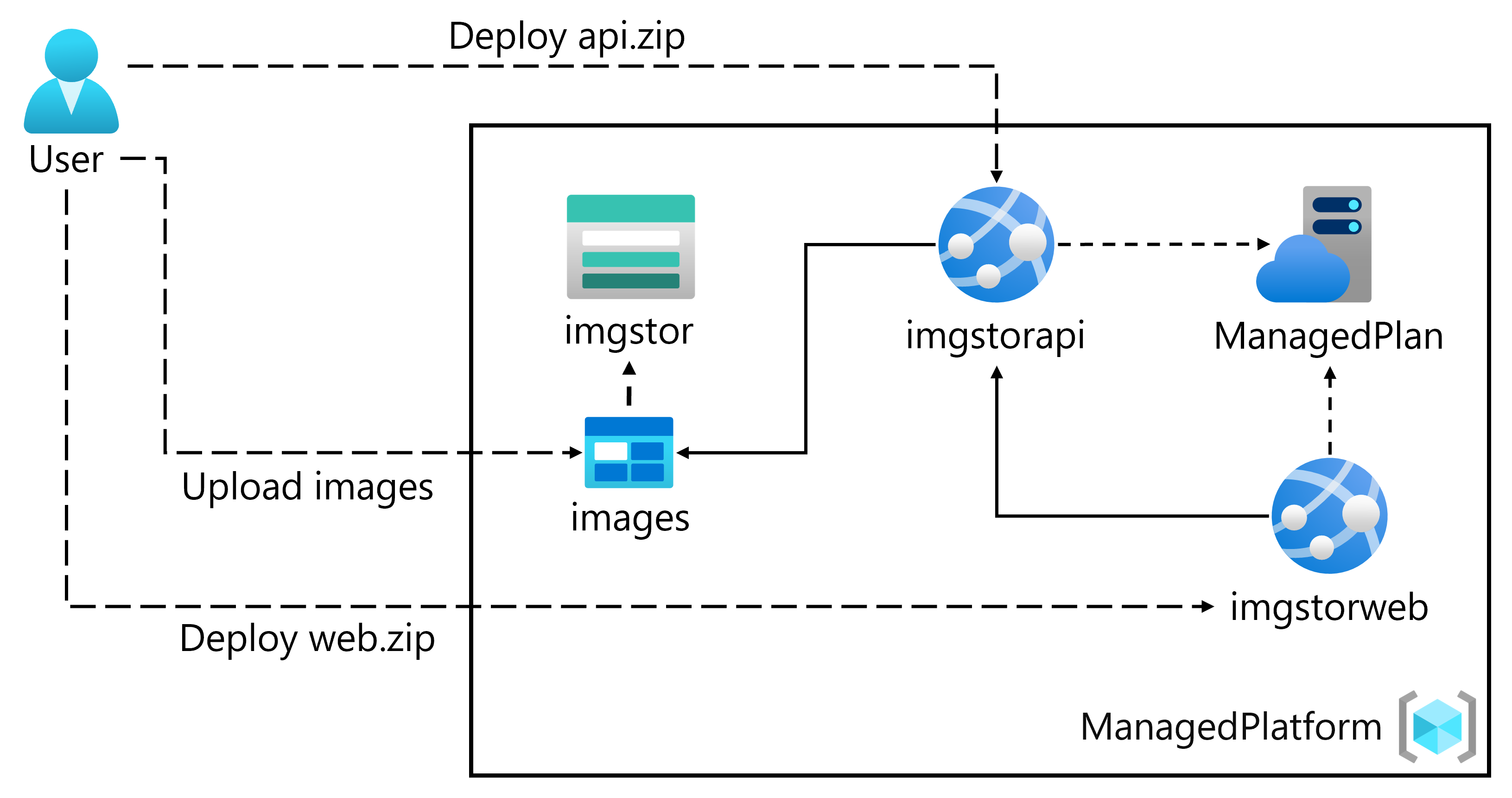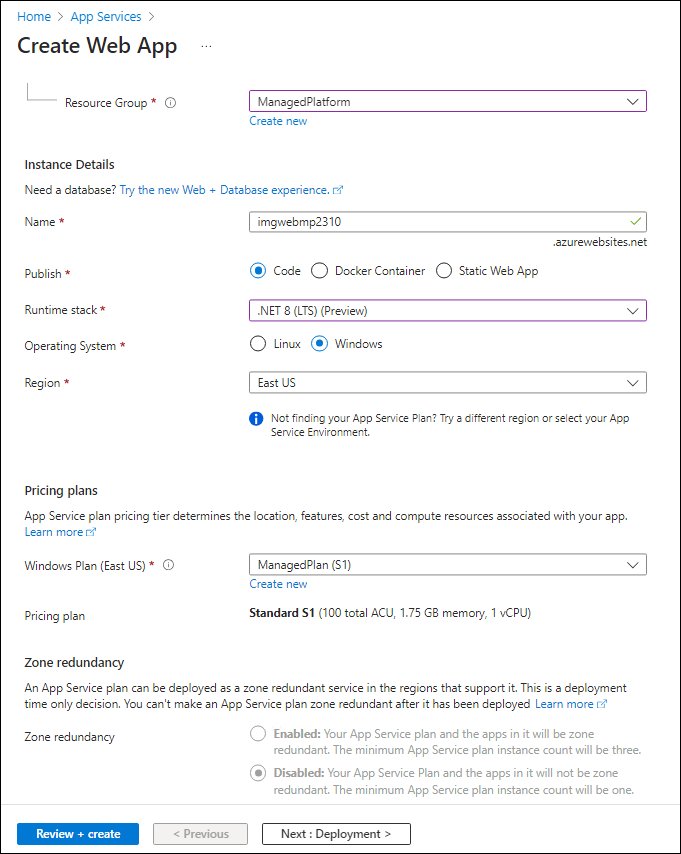Lab 01: Build a web application on Azure platform as a service offering
Microsoft Azure user interface
Given the dynamic nature of Microsoft cloud tools, you might experience Azure UI changes that occur after the development of this training content. As a result, the lab instructions and lab steps might not align correctly.
Microsoft updates this training course when the community alerts us to needed changes. However, cloud updates occur frequently, so you might encounter UI changes before this training content updates. If this occurs, adapt to the changes, and then work through them in the labs as needed.
Instructions
Before you start
Sign in to the lab environment
Sign in to your Windows 11 virtual machine (VM) by using the following credentials:
- Username:
Admin - Password:
Pa55w.rd
Note: Your instructor will provide instructions to connect to the virtual lab environment.
Review the installed applications
Find the taskbar on your Windows 11 desktop. The taskbar contains the icons for the applications that you’ll use in this lab, including:
- Microsoft Edge
- File Explorer
- Terminal
- Visual Studio Code
Lab Scenario
In this lab, you will explore how to create a web application on Azure by using the PaaS model. After the web application is created, you will learn how to upload existing web application files by using the Apache Kudu zip deployment option. You will then view and test the newly deployed web application.
View this video by right-clicking this video link and select ‘Open link in a new tab / new window’.

Architecture diagram

Exercise 1: Build a backend API by using Azure Storage and the Web Apps feature of Azure App Service
Task 1: Open the Azure portal
-
On the taskbar, select the Microsoft Edge icon.
-
In the browser window, browse to the Azure portal at
https://portal.azure.com, and then sign in with the account you’ll be using for this lab.Note: If this is your first time signing in to the Azure portal, you’ll be offered a tour of the portal. If you prefer to skip the tour, select Maybe later to begin using the portal.
Task 2: Create a Storage account
-
In the Azure portal, use the Search resources, services, and docs text box to search for Storage Accounts, and then in the list of results, select Storage Accounts.
-
On the Storage accounts blade, select + Create.
-
On the Create a storage account blade, on the Basics tab, perform the following actions, and then select Review + create:
Setting Action Subscription drop-down list Retain the default value Resource group section Select Create new, enter ManagedPlatform, and then select OK Storage account name text box Enter imgstor[yourname] Region drop-down list Select (US) East US Primary service No changes Performance section Select the Standard option Redundancy drop-down list Select Locally-redundant storage (LRS) The following screenshot displays the configured settings on the Basics tab of the Create a storage account blade.

-
On the Review + create tab, review the options that you selected during the previous steps.
-
Select Create to create the storage account by using your specified configuration.
Note: Wait for the creation task to complete before you proceed with this lab.
-
On the Overview blade, select the Go to resource button to navigate to the blade of the newly created storage account.
-
On the Storage account blade, in the Security + networking section, select Access keys.
-
On the Access keys blade, review any one of the Connection strings (using Show button), and then record the value of either Connection string boxes in Notepad. The Keys are platform managed encryption keys and are not used for this lab.
Note: It doesn’t matter which connection string you choose. They are interchangeable.
-
Open Notepad, and then paste the copied connection string value to Notepad. You’ll use this value later in this lab.
Task 3: Upload a sample blob
-
On the Storage Account blade, in the Data storage section, select the Containers link.
-
On the Containers blade, select + Container.
-
In the New container window, perform the following actions, and then select Create.
Setting Action Name text box Enter images -
On the Containers blade, navigate into the newly created images container.
-
On the images blade, select Upload.
-
In the Upload blob window, perform the following actions:
Setting Action Files section Select Browse for files or use the drag and drop feature File Explorer window Browse to Allfiles (F):\Allfiles\Labs\01\Starter\Images, select the grilledcheese.jpg file, and then select Open Overwrite if files already exist check box Ensure that the check box is selected, and then select Upload Note: Wait for the blob to upload before you continue with this lab.
Task 4: Create a web app
-
On the Azure portal’s navigation pane, select Create a resource.
-
On the Create a resource blade, in the Search services and marketplace text box, enter Web App, and then select Enter.
-
On the Marketplace search results blade, select the Web App result.
-
On the Web App blade, select Create.
-
On the Create Web App blade, on the Basics tab, perform the following actions, and then select the Monitor + secure tab:
Setting Action Subscription drop-down list Retain the default value Resource group section Select ManagedPlatform Name text box Enter imgapi[yourname] Secure unique default hostname Disabled Publish section Select Code Runtime stack drop-down list Select .NET 8 (LTS) Operating System section Select Windows Region drop-down list Select the East US region Windows Plan (East US) section Select Create new, enter the value ManagedPlan in the Name text box, and then select OK Pricing plan section Select Standard S1 The following screenshot displays the configured settings on the Create web app blade.

-
On the Monitor + secure tab, in the Enable Application Insights section, select No, and then select Review + create.
-
On the Review + create tab, review the options that you selected during the previous steps.
-
Select Create to create the web app by using your specified configuration.
Note: Wait for the web app to be created before you continue with this lab.
-
On the Overview blade, select the Go to resource button to navigate to the blade of the newly created web app.
Task 5: Configure the web app
-
On the App Service blade, in the Settings section, select the Environment variables link.
-
In the App settings tab, select + Add. Enter the following information in the Add/Edit application setting pop-up dialog:
Setting Action Name text box Enter StorageConnectionString Value text box Paste the storage connection string that you previously copied to Notepad Deployment slot setting check box Retain the default value -
Select Apply to close the pop-up dialog and return to the App settings section.
-
At the bottom of the App settings section, select Apply.
Note: You may receive a warning that your app may restart when updating app settings. Select Confirm. Wait for your application settings to save before you continue with the lab.
-
To get the App Service’s URL, go to the Overview link, copy the value from the Default domain section, and then paste it to Notepad. Prepend
https://to the domain name in Notepad. You’ll use this value later in the lab.Note: At this point, the web server at this URL will return a placeholder webpage. You haven’t deployed any code to the Web App yet. You’ll deploy code to the Web App later in this lab.
Task 6: Deploy an ASP.NET web application to Web Apps
-
On the taskbar, select the Visual Studio Code icon.
-
On the File menu, select Open Folder.
-
In the File Explorer window, browse to Allfiles (F):\Allfiles\Labs\01\Starter\API, and then select Select Folder.
Note: Ignore any prompts to add required assets to build and debug and to run the restore command to address unresolved dependencies.
-
On the Explorer pane of the Visual Studio Code window, expand the Controllers folder, and then select the ImagesController.cs file to open the file in the editor.
-
In the editor, in the ImagesController class on line 26, observe the GetCloudBlobContainer method and the code used to retrieve a container.
-
In the ImagesController class on line 36, observe the Get method and the code used to retrieve all blobs asynchronously from the images container.
-
In the ImagesController class on line 68, observe the Post method and the code used to persist an uploaded image to Storage.
-
On the taskbar, select the Terminal icon.
-
At the open terminal, enter the following command, and then select Enter to sign in to the Azure Command-Line Interface (CLI):
az login -
In the Microsoft Edge browser window, enter the email address and password for your Microsoft account, and then select Sign in.
-
Return to the currently open Terminal window. Wait for the sign-in process to finish.
-
Within the terminal, enter the following command, and then select Enter to list all the apps in your ManagedPlatform resource group:
az webapp list --resource-group ManagedPlatform -
Enter the following command, and then select Enter to find the apps that have the imgapi* prefix:
az webapp list --resource-group ManagedPlatform --query "[?starts_with(name, 'imgapi')]" -
Enter the following command, and then select Enter to render only the name of the single app that has the imgapi* prefix:
az webapp list --resource-group ManagedPlatform --query "[?starts_with(name, 'imgapi')].{Name:name}" --output tsv -
Enter the following command, and then select Enter to change the current directory to the Allfiles (F):\Allfiles\Labs\01\Starter\API directory that contains the lab files:
cd F:\Allfiles\Labs\01\Starter\API\ -
Enter the following command, and then select Enter to deploy the api.zip file to the web app that you created previously in this lab:
az webapp deployment source config-zip --resource-group ManagedPlatform --src api.zip --name <name-of-your-api-app>Note: Replace the <name-of-your-api-app> placeholder with the name of the web app that you created previously in this lab. You recently queried this app’s name in the previous steps.
Wait for the deployment to complete before you continue with this lab.
-
On the Azure portal’s navigation pane, select the Resource groups link.
-
On the Resource groups blade, select the ManagedPlatform resource group that you created previously in this lab.
-
On the ManagedPlatform blade, select the imgapi[yourname] web app that you created previously in this lab.
-
From the App Service blade, select Browse.
Note: The Browse command will perform a GET request to the root of the website, which returns a JavaScript Object Notation (JSON) array. This array should contain the URL for your single uploaded image in your Storage account.
-
Return to your browser window that contains the Azure portal.
-
Close the currently running Visual Studio Code and Terminal applications.
Review
In this exercise, you created a web app in Azure, and then deployed your ASP.NET web application to Web Apps by using the Azure CLI and Apache Kudu zip file deployment utility.
Exercise 2: Build a front-end web application by using Azure Web Apps
Task 1: Create a web app
-
On the Azure portal’s navigation pane, select Create a resource.
-
On the Create a resource blade, in the Search services and marketplace text box, enter Web App, and then select Enter.
-
On the Marketplace search results blade, select Web App.
-
On the Web App blade, select Create.
-
On the Create Web App blade, on the Basics tab, perform the following actions, and then select the Monitor + secure tab:
Setting Action Subscription drop-down list Retain the default value Resource group section Select ManagedPlatform Name text box Enter imgweb[yourname] Secure unique default hostname Disabled Publish section Select Code Runtime stack drop-down list Select .NET 8 (LTS) Operating System section Select Windows Region drop-down list Select the East US region Windows Plan (East US) section Select ManagedPlan (S1)
The following screenshot displays the configured settings on the Create web app blade.

-
On the Monitor + secure tab, in the Enable Application Insights section, select No, and then select Review + create.
-
From the Review + create tab, review the options that you selected during the previous steps.
-
Select Create to create the web app by using your specified configuration.
Note: Wait for the creation task to complete before you continue with this lab.
-
On the Overview blade, select the Go to resource button to navigate to the blade of the newly created web app.
Task 2: Configure a web app
-
On the App Service blade, in the Settings section, select the Environment variables link.
-
In the Environment variables section, perform the following actions, select Apply, and then select Continue:
Setting Action App settings tab Select New application setting Add/Edit application setting pop-up dialog In the Name text box, enter ApiUrl Value text box Enter the web app URL that you copied previously in this lab. Note: Make sure you include the protocol https://, in the URL that you copy into the Value text box for this application setting Deployment slot setting check box Retain the default value, and then select OK Click Apply in the top menu This will save the configuration value you just entered Note: Wait for the application settings to save before you continue with this lab.
Task 3: Deploy an ASP.NET web application to Web Apps
-
On the taskbar, select the Visual Studio Code icon.
-
On the File menu, select Open Folder.
-
In the File Explorer window, browse to Allfiles (F):\Allfiles\Labs\01\Starter\Web, and then select Select Folder.
Note: Ignore any prompts to add required assets to build and debug and to run the restore command to address unresolved dependencies.
-
On the Explorer pane of the Visual Studio Code window, expand the Pages folder, and then select the Index.cshtml.cs file to open the file in the editor.
-
In the editor, in the IndexModel class on line 30, observe the OnGetAsync method and the code used to retrieve the list of images from the API.
-
In the IndexModel class on line 41, observe the OnPostAsync method and the code used to stream an uploaded image to the backend API.
-
On the taskbar, select the Terminal icon.
-
At the open terminal, enter the following command, and then select Enter to sign in to the Azure CLI:
az login -
In the Microsoft Edge browser window, enter the email address and password for your Microsoft account, and then select Sign in.
-
Return to the currently open Terminal window. Wait for the sign-in process to finish.
-
Enter the following command, and then select Enter to list all the apps in your ManagedPlatform resource group:
az webapp list --resource-group ManagedPlatform -
Enter the following command, and then select Enter to find the apps that have the imgweb* prefix:
az webapp list --resource-group ManagedPlatform --query "[?starts_with(name, 'imgweb')]" -
Enter the following command, and then select Enter to render only the name of the single app that has the imgweb* prefix:
az webapp list --resource-group ManagedPlatform --query "[?starts_with(name, 'imgweb')].{Name:name}" --output tsv -
Enter the following command, and then select Enter to change the current directory to the Allfiles (F):\Allfiles\Labs\01\Starter\Web directory that contains the lab files:
cd F:\Allfiles\Labs\01\Starter\Web\ -
Enter the following command, and then select Enter to deploy the web.zip file to the web app that you created previously in this lab:
az webapp deployment source config-zip --resource-group ManagedPlatform --src web.zip --name <name-of-your-web-app>Note: Replace the <name-of-your-web-app> placeholder with the name of the web app that you created previously in this lab. You recently queried this app’s name in the previous steps.
Wait for the deployment to complete before you continue with this lab.
-
On the Azure portal’s navigation pane, select Resource groups.
-
On the Resource groups blade, select the ManagedPlatform resource group that you created previously in this lab.
-
On the ManagedPlatform blade, select the imgweb[yourname] web app that you created previously in this lab.
-
On the App Service blade, select Browse.
-
Observe the list of images in the gallery. The gallery should list a single image that was uploaded to Storage previously in the lab.
-
In the Contoso Photo Gallery webpage, in the Upload a new image section, perform the following actions:
a. Select Browse.
b. In the File Explorer window, browse to Allfiles (F):\Allfiles\Labs\01\Starter\Images, select the banhmi.jpg file, and then select Open.
c. Select Upload.
-
Observe that the list of gallery images has updated with your new image.
Note: In some rare cases, you might need to refresh your browser window to retrieve the new image.
-
Return to the browser window that contains the Azure portal.
-
Close the currently running Visual Studio Code and Terminal applications.
Review
In this exercise, you created an Azure web app and deployed an existing web application’s code to the resource in the cloud.